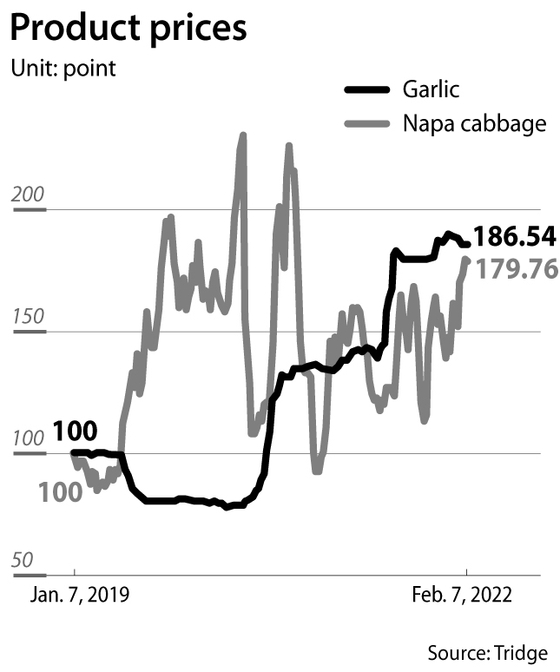Inflation hits the Korean dinner table harder than elsewhere
![Representative ingredients in Korea are 34.8 percent more expensive over the past couple of years, according to market tracker Tridge. [JOONGANG PHOTO]](https://koreajoongangdaily.joins.com/data/photo/2022/02/19/b984c5d8-338d-4aa8-be30-a8d543e60d2a.jpg)
Representative ingredients in Korea are 34.8 percent more expensive over the past couple of years, according to market tracker Tridge. [JOONGANG PHOTO]
Food inflation seems to be hitting the world unevenly, with the cost of the average home-cooked meal in Korea rising faster than the same in other countries.
According to a Feb. 17 report by Tridge, a Korean market research company, prices for ingredients used in a representative local meal was up 34.8 percent in Korea since January 2020.
For Korea, the researchers chose rice, garlic, onion, potato, dried chilli, white soybean and napa cabbage for the study, as these are used most frequently in making Korean home-cooked meals.
Boiled rice, kimchi and doenjang jjigae (fermented soybean paste stew) are the most popular dishes in Korean households, according to Korea Health Industry Development Institute.
Tridge compared the rise in prices of representative shopping baskets in countries globally, adjusting the ingredients depending on what is most popular in each location.
In the United States, the products in the study were avocados, lettuce, onions, potatoes and tomatoes, and the prices of these were up 11.3 percent.
"We chose items that are relatively more susceptible to price fluctuation among each country's household staples," explained a spokesperson for Tridge.
The basket in Brazil is up 16.9 percent, and China's shopping list is 0.9 percent more expensive.
A production slump caused by the weather and supply-chain bottlenecks is leading to an increase in prices. Social-distancing rules increased demand for home-cooked meals, leading to the increased demand for farm produce.
"Korea has a comparatively high threshold for the export and import of foodstuffs," said Cheon Jin-woo, a researcher at Tridge. That means that cheap ingredients imported from other countries cannot be a sufficient alternative for consumers.
"In countries such as the United States and Brazil, where the market size is huge, supply shortages of a product and subsequent price increases are not likely to lead to the overall price increases of the whole product category, as there is always an alternative," said Cheon. "But in Korea, it is hard to tame the inflation as finding an alternative is more difficult due to the high dependence on local products."

In Korea, garlic prices were up 36.1 percent on year in February, and 134.7 percent compared to the pre-pandemic level of 2019, mainly because of environmental conditions. In April and May 2021, it rained more frequently than average, resulting in overgrowth. Overgrown garlic is mostly discarded due to low marketability.
Cheon also cited the strong preferences toward local products for the price increases, as traditional Korean food often requires ingredients mostly produced in Korea.
Napa cabbage, the main ingredient for kimchi, got 21.4 percent more expensive on year, because of abnormal weather conditions and the resulting spread of soft rot.
Statistics Korea found that the prices of tools and machinery necessary for agriculture and livestock businesses rose 4.7 percent in 2021 due to soaring costs for fuel, feedstuff and labor.
Consumers at grocery stores are stumped by the price tags.
"It's not like we can stop eating kimchi just because napa cabbage and chilli powder got more expensive," said a housewife, 61, living in Mapo District, western Seoul, "I'm shocked to see that a day's worth of food costs more than 100,000 won ($83.7)."
The price increases of some items do not mean that everything on the dinner table got overly expensive.
"The index is for understanding the trend, not the precise price fluctuation," said Seong Tae-yoon, an economics professor at Yonsei University, "so we should not conclude that the Korean meals are always more expensive than those in the United States based on the partial data."
BY BAE JUNG-WON [shin.hanee@joongang.co.kr]










with the Korea JoongAng Daily
To write comments, please log in to one of the accounts.
Standards Board Policy (0/250자)